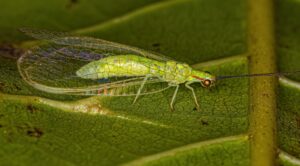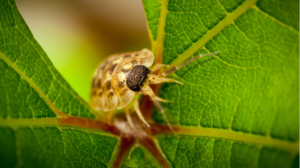Lacewings are small insects known for their intricate translucent wings and fascinating appearance. While they are beneficial predators in gardens, discovering them in your home may cause for concern. In this blog post, we will explore the reasons why lacewings might entering your house and how to properly manage their presence.
Why Have I Got Lacewings in My House?
Lacewings are small, beneficial insects belonging to the Chrysopidae family. These larvae are avid predators of garden pests like aphids, mites, and other small insects, making lacewings highly valued in natural pest control. And the reasons they get into your home are,

- Attracted to Light: Lacewings, like many insects, are attracted to light. If you have bright outdoor lights or keep your windows open with lights on inside, lacewings might be drawn to your home. They often find their way indoors through small gaps around windows and doors.
- Seeking Shelter: During colder months, lacewings may seek refuge indoors. They are not adapted to survive freezing temperatures, so they might enter homes in search of warmth and shelter.
- Accidental Entry: Sometimes, lacewings simply end up indoors by accident. They might be carried in on plants or flowers brought from outside or inadvertently fly in when doors or windows are left open.
How to Prevent Lacewings from Entering Your Home?
To prevent lacewings from entering your home or your personal space, do the below mentioned steps.
- Seal Entry Points: Inspect your home for gaps around windows, doors, and other entry points. Use weather stripping, caulk, or other sealants to close these gaps and prevent lacewings from entering.
- Use Screens: Ensure that all windows and vents are equipped with screens in good repair. This will help keep lacewings and other insects out while allowing fresh air to circulate.
- Minimize Outdoor Lighting: Reduce the use of bright outdoor lights, especially near entry points. Consider using yellow bug lights, which are less attractive to insects.
- Keep Doors and Windows Closed: When possible, keep doors and windows closed, especially in the evening when lights are on indoors. If you need to have them open, consider using screens or installing a mesh curtain.
What to Do If You Have Lacewings Indoors?

If you find lacewings indoors, we can easily manage their presence by taking some steps and those are,
- Gentle Removal: If you find a lacewing inside, you can gently capture it using a cup and a piece of paper and release it back outside. They are delicate, so handle them with care.
- Vacuum: For larger numbers of lacewings, a vacuum cleaner can be an effective way to remove them without causing harm. Be sure to empty the vacuum outside to release the insects.
- Natural Repellents: Certain natural repellents, like essential oils (e.g., eucalyptus or lavender), may help deter lacewings. Spray diluted essential oil solutions around potential entry points.
Conclusion
While lacewings are beneficial insects in outdoor settings, their presence inside your home can be disruptive. You can maintain a pest-free living space by understanding the reasons for their infestation and implementing effective management strategies. If you want more details about lacewings or to remove lacewings, contact the Empire Pest Control, the best pest control services in London. We have trained persons who have experience in pest control strategies. They can easily eliminate the pest from your house.






